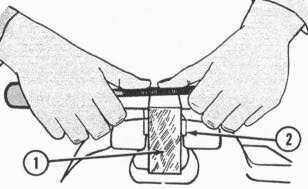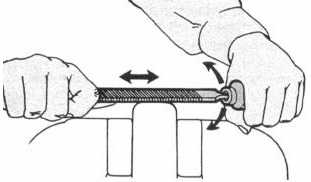TM 9-243
USING A FILE
SELECTING PROPER FILE
1.
For heavy, rough cutting, use a large, coarse,
double-cut file.
2.
For finishing cuts, use a second or smooth-cut,
single-cut file.
3.
When working on cast iron, start with a bastard-cut
file and finish with a second-cut file.
4.
When filing soft metal, start with a second-cut file
and finish with a smooth-cut file.
5.
When filing hard steel, start with a smooth-cut file
and finish with a dead-smooth file.
6.
When filing brass or bronze, start with a bastard-cut
file and finish with a second or smooth-cut file.
7.
When filing aluminum, lead, or babbitt metal, use a
standard-cut curved-tooth file.
8.
For small work, use a short file. For medium-sized
work, use an 8-inch file. For large work, use a file
that is most convenient.
METHOD OF FILING
1.
Clamp the work (1) securely in a vise so that the
area to be filed is horizontal and is parallel to and
projecting slightly above the vise jaws (2).
2.
Hold the file handle in one hand, thumb on top, and
hold the end of the file with the fingers of the other
hand.
work on the return stroke, it will become dull much
sooner than it should.
4.
When filing soft metals, using pressure on the return
stroke helps keep the cuts in the file clean.
5.
Use a rocking motion when filing round surfaces.
6.
When using a new file, applying too much pressure
will cause the teeth to break off. Do not force the file.
File slowly, lightly, and steadily. Too much speed
and too much pressure causes the file to rock,
rounding off the corners of the work.
DRAW FILING
1.
Draw filing is used to produce a very smooth and
true surface. Hold the file at right angles to the
direction of the strokes, keeping your hands close
together to prevent bending and breaking the file.
2.
Pressure should not be great and can remain the
same on the back stroke as on the draw stroke. The
speed of filing is not important.
3.
For extra smooth surfaces, wrap a piece of emery
cloth around the file and stroke in the same manner.
3.
When filing hard metals, apply pressure on the for-
ward stroke only. Unless the file is lifted from the
28-4




